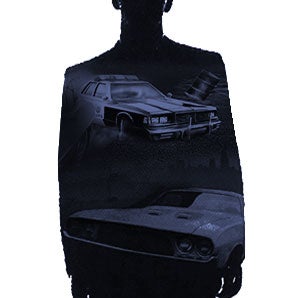Luke Reilly
Curated From www.ign.com Check Them Out For More Content.
In April 1908, Newcastle upon Tyne man Gladstone Adams was driving his Darracq-Charron motorcar back from the FA Cup final between Newcastle United and Wolverhampton Wanderers. Newcastle had lost and, to make matters worse, Adams’ journey home was being delayed by snow. That is, it kept covering his windscreen and he had to repeatedly stop and get out of the car to clear it.
Some kind of innovation was needed. There had to be something that would help people see where they were going.
As it turned out, there was; a few years later Adams invented his own windscreen wiper. He patented the design and became one of several people from around the beginning of the 1900s credited with conceiving of similar devices, although his version of the windscreen wiper never made it into production.
Nearly a century down the track, Newcastle upon Tyne developer Reflections had found itself riding high on a purple patch of PlayStation success, propelled by the popular Destruction Derby series it had developed for legendary British publisher Psygnosis. 3D driving games had quickly become Reflections’ specialty, but the team knew you couldn’t tread water in a genre long famous for being on the cutting edge of video game technology. Some kind of innovation was needed. Something that would help people see where the future of driving games was going.
As it turned out, Reflections founder Martin Edmondson had just such an idea – and, unlike their fellow Novocastrian’s windscreen wipers, Edmondson’s idea did make it into production.
And it completely redefined what a driving game could be, forever.
Founded in 1984, Reflections spent the bulk of its first decade building action games for early home computers like the BBC Micro and Amiga, but by the mid ’90s it would become a house of horsepower. Reflections established its panel-punishing prowess on PlayStation very early; indeed, the original Destruction Derby was released in October 1995. At this stage, it had barely been a month since the original PlayStation had officially launched in the West.
A highly praised sequel arrived just over a year later, with a raft of technical improvements, and in 1997 Reflections released the competent but unremarkable Monster Trucks (otherwise known as Thunder Truck Rally in North America). However, while the Destruction Derby series would continue, the partnership between Reflections and publisher Psygnosis would not.
Unshackled from its publisher commitments, Reflections pivoted to something else. That something else was Driver, and it was going to be something special. GT Interactive certainly thought so. By December 1998, it was so impressed the publisher literally bought Reflections entirely.

Driver, which first launched in June 1999, was unlike anything that had come before it. These days it seems less common for a game to come along and establish the foundations of what’s essentially a brand new sub-genre, but wind the clock back a couple of decades and it was happening with steady regularity. In the scheme of driving games, Driver was truly one-of-a-kind.
Driver did more than just take the brash, car chase gameplay from the original top-down Grand Theft Auto games and bring it to life in 3D – it distilled the mayhem of some of Hollywood’s greatest ever car chase classics and made them playable.
Smokey and the Bandit, The Blues Brothers, The Cannonball Run, Bullitt – the team took inspiration from countless car chase classics. Martin Edmondson was particularly passionate about them; Walter Hill’s 1978 film The Driver was one of the first movies he ever saw at a cinema.
The Driver, a minimalist neo-noir action thriller set in the underbelly of LA, was not particularly successful upon its release – but it has amassed an admirable legacy. It didn’t just inspire Driver, that is; Nicolas Winding Refn’s 2011 film Drive respectfully shares several thematic similarities, it was a core inspiration for Edgar Wright’s 2017 film Baby Driver, and it’s been referenced on multiple occasions by Quentin Tarantino.

The Driver’s influence on Driver the game goes far beyond the name, too. The infamous garage test at the beginning of Driver’s story mode was directly inspired by a strikingly similar scene in The Driver, where Ryan O’Neal’s unnamed getaway driver meticulously mangles a Mercedes (all while still keeping it drivable) in a calculated display of his precision driving abilities. The twist in Driver is that players are punished for denting the car. Ironically, doing so will trigger the very same car crash sound effect specifically used in this very scene in The Driver (alongside a host of other car chase movies from the ’70s and ’80s, mostly from 20th Century Fox).
Driver’s garage test is regarded by some as harder than any mission in the game that followed, although I can’t imagine that’s a sentiment that any Driver fan who actually played the game’s finale would share (‘The President’s Run’ is monumentally more difficult than the garage test). Playing and completing the test for the first time in many, many years, I can’t help but wonder whether its reputation as an uncommonly gruelling challenge is a little overblown. Admittedly, Driver was essentially a religion for me during the last year-or-so of the original PlayStation so I’m not the best gauge – but I’ll note my 15-year-old son needed just four cracks to beat it, playing on original hardware. So I can’t say it stumped him, either.

That said, if you did in fact bounce off Driver because of its unfriendly first mission, you missed out on an absolutely amazing and unprecedented driving experience.
Sliding behind the wheel of a slate of ’70s muscle cars as former race driver-turned-undercover cop Tanner, it was your job to lay rubber across four US cities – Miami, San Francisco, Los Angeles, and New York – all in the name of high-speed justice. Each of these cities are fascinatingly distinct. Sun-drenched Miami features lengthy causeways and addictive bridge leaps, while San Francisco is packed with drastic elevation changes, trams, and the iconic Golden Gate Bridge. LA’s missions occur exclusively at night, amplifying the seediness (and again paying homage to The Driver, in which director Hill deliberately shot all the chase sequences for at night). New York is a dense maze of grids and tunnels, framed with high buildings.

The maps were incredible, but so too was the handling. Driver’s hulking American pony cars and land yachts weren’t exactly rapid or nimble by typical gaming standards for the time, but they were nonetheless outstandingly satisfying to throw into elbows-out powerslides and over huge jumps (where the era-accurate suspension would often see them bouncing a second time as the soggy springs absorbed their All-American bulk).
From its flying hubcaps to its fabulous funk soundtrack, Driver’s dedication to bringing the spirit of ’70s and ’80s car chases back to life on PlayStation was dazzling. Sentimentally speaking, it’s one of my favourite games of all time. Depending on what mood you catch me in, it may be my outright favourite, ever.

For clarity, Reflections didn’t quite break through alone. Angel Studios’ Midtown Madness did, after all, speed onto PCs in 1999 also (a few weeks before Driver hit PlayStation). An open world racer set in Chicago, Midtown Madness set the tone for taking traditional racing to the streets. Open worlds would become the studio’s area of expertise, and Angel Studios (now Rockstar San Diego) would later flex that strength in the likes of Midnight Club, Smuggler’s Run, and Red Dead Redemption.
Still, that Ubisoft has let the legacy of Driver languish since the release of 2011’s much-loved Driver: San Francisco is downright depressing. A groundbreaking achievement in every way, Driver deserves so much better.
Today, Driver is a relic. In 1999, however, Driver was truly ahead of its time. A pioneer. Contemporaneous audiences agreed. Or, at least, the ones that could pass the first mission did. It’s one of the top 30 best-selling games on PlayStation, ever. Wedged roughly somewhere between the acclaimed super sequel Tony Hawk’s Pro Skater 2 and monster hit Resident Evil 3, Driver was certainly no sales slouch.

In other words, it’s more than some curio in the history of open world driving games that some gamers may otherwise believe began with the likes of Grand Theft Auto III.
Perhaps you disagree. After all, all Reflections had to do was assemble four, enormous free-roaming city environments (the likes of which had never been built before), craft AI that could respond and effectively pursue players through them (which didn’t exist), compliment it with a class-leading vehicular damage system (that few racing developers of the era seemed capable of matching), and throw in a full replay editor for players to create custom car movies (on a console with 2MB of RAM).
Easy, right?
Well, in the words of Driver’s own tricky tutorial: show us what you can do.
Luke is a Senior Editor on the IGN reviews team. You can chat to him on Twitter @MrLukeReilly.

